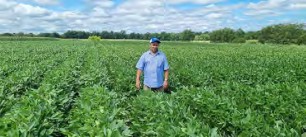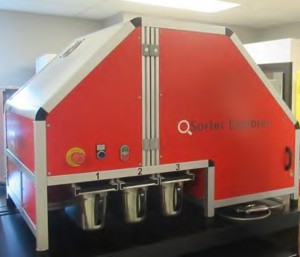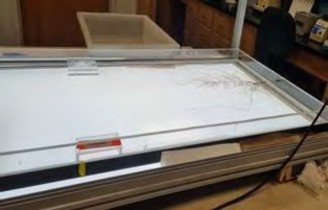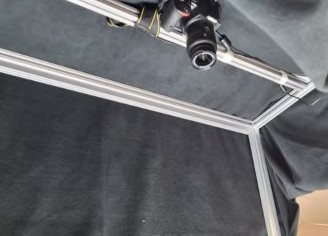Utilizing and Teaching Modern Phenomics in African Crops for Environmental Stress Tolerance
Felix Fritschi, University of Missouri Hussein Shimelis, University of KwaZulu-Natal
SYNOPSIS
The majority of plant breeders and plant scientists in Africa are educated at the African Center for Crop Improvement (ACCI), located at the University of KwaZulu-Natal (UKZN) in South Africa. ACCI trains postgraduate students in Plant Breeding, Plant Genetics, Plant Pathology, and Agronomy.
The Fritschi Lab and collaborators including Drs. Kristin Bilyeu (USDA-ARS) and Andrew Scaboo (Univ. of Missouri) are interested in a long-term research and education collaboration with ACCI with the aim of helping to build plant science capacity in Africa and work at the forefront of plant productivity issues including abiotic stress resistance and climate change adaptation. To build on initial interactions and develop a foundation for future collaborations, we hosted Dr. Hussein Shimelis, Professor and Chair of Crop Science and Deputy Director African Centre for Crop Improvement at the University of KwaZulu-Natal at MU from June 1 through August 31, 2022. Dr. Hussien Shimelis is an important partner due to his expertise in plant breeding teaching and research in the “research for development” realm. Professor Shimelis currently leads the most important graduate level plant breeding program in Africa at the University of KwaZulu-Natal and had a desire to visit the University of Missouri to see first-hand the plant phenomics and genomics research activities aimed at improving soybean and other crop species. During his visit, Dr. Shimelis spent time in Dr. Fritschi’s lab, visited field and laboratory experiments, and shadowed the lab members as they conducted high-througput phenotyping campaigns aimed at identifying more drought tolerant soybean genotypes. In addition to learning about phenotyping platforms and methods, Professor Shimelis engaged with Dr. Kristin Bilyeu and her team to learn about state-of-the art methods in soybean molecular biology and genetics. From Dr. Scaboo and his group of researchers, Professor Shimelis gained insights into the workings of a modern public soybean breeding program. These interactions provided useful insights for Dr. Shimelis’ research and teaching efforts, including understanding of cutting edge approaches on genomic selection that he was able to incorporate into a draft of his textbook. The College of Agriculture, Food, and Natural Resources (CAFNR) International Programs facilitated additional networking opportunities for Dr. Shimelies, including visits to the University of Cinncinati, University of Illinois, and exchanges with Borlaug Fellows that were hosted by CAFNR during his visit. Critically, he also shared with MU faculty and USDA/ARS researchers his experiences with plant breeding in Africa; those discussions set the stage for future collaborations.
Professor Shimelis and Dr. Fritschi have been in regular contact since Dr. Shimelis returned to South Africa. We continue to identify opportunities to collaborate and intend to build on the relationships that were strengthened thanks to the University of Missouri & South Africa Education Program.
End of scientific visit report – Hussein Shimelis
University of Missouri & South Africa Education Program (UMSAEP)

Objectives:
The overall objectives of the scientific visit were
-
to learn the plant phenomics and genomics platforms at University of Missouri (UM) and collaborating institutions for evaluation of plant genotypes under stress and non-stressed conditions for genetic improvement programs
-
to develop a teaching material on research methodology by integrating genomic-assisted breeding and genomic data analysis
Brief summary of the scientific visit Plant phenomics and genomics analyses
This visit focused on learning phenomic and genomic tools to apply in current and future breeding programs. The lesson can have a multiplicative effect through mentoring postgraduate students in the African Center for Crop Improvement (ACCI) or other plant breeding programs. The ACCI trains PhD-level postgraduate students selected from countries in Africa in Crop Sciences (Plant Breeding, Plant Genetics, Plant Pathology, and Agronomy) who are involved in demand-led cultivar development.
1. Marker-assisted breeding and genomic data analysis
Marker-assisted selection for high oleic soybean
I had full access to Dr Kristin Bilyeu’s molecular biology laboratory and soybean pre-breeding research sites (Figure 1). With her research group, I learned molecular genetic profiling to distinguish homozygous or heterozygous high oleic mutants and wild-type soybean individuals. The purpose was for the genetic advancement of homozygous high oleic mutants. The seed profile of her breeding populations was scanned, targeting four gene selections for high oleic/low linolenic oil traits and one or two gene selections for
low or ultra-low raffinose family of oligosaccharides. The knowledge will allow marker-assisted selection and deployment of new soybean or related crop varieties for food or feed production.
I also had the opportunity to learn from Dr Bilyeu’s field research, including the soybean crossing block, fast-neutron induced mutants, and the pre-breeding populations and genotype sampling for molecular genetic analysis for the above gene combinations. Furthermore, I attended the weekly bioinformatics project meeting that enlightened me on the progress and outcomes of the genomic selection and genome-wide association study of Drs Bilyeu’s and Scaboo’s group and their PhD candidate.
Dr Bilyeu’s work on gene discoveries, maintenance and regeneration of soybean genetic resources, genetic advancement and precision breeding is vital for the accelerated development of new and improved crop cultivars. I treasure it as an essential lesson to make our research programs innovative and at the competitive edge of agricultural science.
Genomic data analysis

A

B
I drafted a textbook on research methodology for teaching senior undergraduate students in agricultural sciences, postgraduate students in the fields of Crop Sciences and agricultural educators and researchers. I included aspects of genomic-assisted breeding and genomic data analysis during this scientific visit in this teaching resource. I have reviewed the basic principles of molecular genetic parameters and learned the hands-on molecular data assembly and analysis to compute diverse genetic diversity statistics and deduce population structures of test genotypes in this book. The lessons from genomic data analysis were crucial to developing the draft book. I can effectively teach senior undergraduate and postgraduate plant breeding scholars on molecular data analysis, summary, interpretation and applications in plant breeding programs. In addition to enriching the textbook and academic knowledge gained, the lessons on the genomic tools would also assist in accelerated genotype selection and genetic gains when employing molecular markers and associated agronomic data in our breeding programs.
Figure 1. Advancing high oleic soybean mutants: Note: laboratory profiling of homozygous and heterozygous mutants (A) and examining mutant breeding populations (B)
2 Pre-breeding and breeding of soybean

A

B

C
I visited the soybean genetics, pre-breeding and breeding research at Bay Farm of the UM led by Dr Andrew Scaboo (Figure 2). I learned about the soybean program's breeding goals, stage plans and pipelines. I was demonstrated the marker-assisted selection platform of the program targeting the soybean cyst nematode resistance breeding. Also, I have visited the QSorter® facility (Figure 2C), which enables a rapid and single seed selection of soybean genotypes with key desired traits, such as high oleic and protein content, non-destructively and instantaneously.
Figure 2. Soybean pre-breeding and breeding at Bay Farm and Bradford Research Center. Note: soybean crossing block and breeding populations (A) and QSorter facility (C)
3 High throughput phenotyping for root traits and crop canopy
There is interest in using root traits in crop variety development using emerging root phenotyping and genotyping technologies. Thanks to Dr Felix Fritsch and his research group, I have learned the high throughput root phenotyping, including root preparation, scanning and measurements. The root phenotyping/top-soil root architecture analysis includes shovelomics, root preparation, laboratory analysis, imaging systems and data capturing (Figures 3 & 4). Also, the research group employs drones (fitted with Hyper and FlirDuo cameras) to capture sensed data on crop canopy temperature and solar radiation to aid genotype selection with heat stress tolerance (Figure 4 C & D).

A

B

C
Figure 3. Photos displaying root image analysis in the lab. Note: photo booth (A), tray with soybean root for image capturing (B), and cabled Nikon camera for image taking (C).
During this visit, I completed and published the following paper in the Journal of Plant Breeding with my postdoc fellow from the University of KwaZulu-Natal: Isack Mathew and H. Shimelis. 2022. Genetic analyses of root traits: Implications for environmental adaptation, and new variety development: A Review. Plant Breeding 1–24, DOI: https://doi.org/10.1111/pbr.13049. The paper was inspired by the work of Dr Fritschi and the team and will guide crop breeders in designing and deploying a new generation of crop varieties with desirable yield and root traits.

A
B

C
D
Figure 4. Soybean root phenotyping at Rollins bottom. Note: root samples from the soil (A), root image analysis from different angles, drones prepared for data capture (C and D).
4 Networking and collaboration opportunities
-
In the last week of July, I was invited to visit Dr Tesfaye Mersha’s lab at the University of Cincinnati, Ohio. I learned the next-generation sequencing platform, bioinformatics tools and cloud computing programs useful for basic and translational research in plant genetics involving multidisciplinary teams.
-
I visited the University of Illinois Urbana - Champaign (UIUC) on August 3rd. This allowed me to discuss with the Soybean Innovation Lab (SIL) research collaborators and see the UIUC campus and Research Farm. I had a productive discussion with the SIL team, including Drs Peter Goldsmith, Brian Diers and Rita Mumm. The above visits and interactions will potentially forge collaboration with the SIL team.
Through this trip I learned about the cropping systems spanning the states of Missouri and Illinois. I was excited to see the new generation maize variety with one ear per plant, erect leaf type, relatively short plant height and amenable to high planting density (Figure 5).
-
I participated in the meeting that involved the Scientific Exchange SBS-TBT and Borlaug Fellows with the United States Department of Agriculture and USDA- Foreign Agricultural Service officials in Washington DC in mid-August. The event was inspirational and allowed me to offer mentorship and interact with the new cohort. During this event, I also visited the key cultural sites and learned about general aspects of plant and animal health and its implications for local, regional and international trades.
Figure 5. New generation maize variety with one ear per plant, erect leaf type, relatively short plant height and amenable to high planting density.

5 Summary and outlook
The knowledge gained through the phenotyping and genotyping work will allow us to adapt and employ the techniques for integrating agronomic traits, root traits and agro-physiologic data sets in our pipeline breeding programs in South Africa. We are interested in developing climate-smart crop cultivars with better yield, drought tolerance and high root biomass production to sequester carbon into the soil. Also, the platform will be used to accelerate the registration and commercialization of superior varieties from breeding populations of food crops. In the face of climate change, reduced availability of agricultural lands, diminishing soil fertility and growing populations, the need for accelerating the improvement of yields and resilience in key food crops is now crucial.
-
Acknowledgements
I am thankful to the following group and individuals for making my visit a success.
- The Interdisciplinary Plant Group of UM, for hosting me as a visiting scholar through the UM and the South African Education Project.
- CAFNR International program, Dr Kerry Clark and her team (Lindsey and Judy), for timely facilitating the logistics.
- Dr Kristin Bilyeu and the team (Tina, Anser, Christie and Mark), for the overall support and hospitality.
- Dr Felix Fritschi and the team (Jose, Meghnath, Eric and Emili) and Dr Andrew Sacboo and the Bay Farm team (Clinton and Mariola), for lab and field research support.
- Dr Rita Mumm, for arranging and hosting my visit to UIU-C.
- Dr Tesfaye Mersha, for the invite and hosting to the University of Cincinnati.
- The staff of the University AirBnB (Nancy and Penny: who were like my sisters and who share the same birthday), for friendly and humble conversations and support.
Shimelis Hussein
4th October 2022
University of KwaZulu-Natal, Pietermartizburg Campus South Africa
Reviewed 2025-11-20